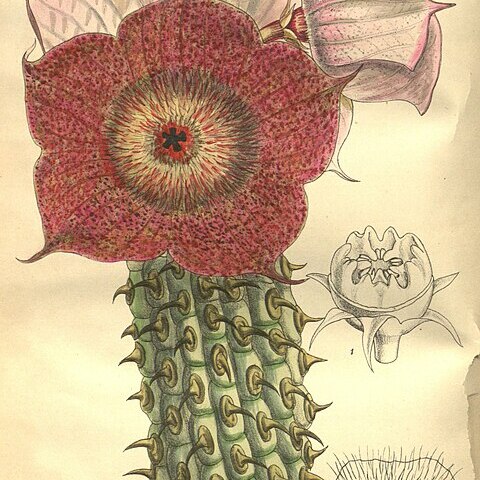Many-stemmed shrub 0.15-1.00 m tall and 0.15-1.00 m or more, broad. Stems 0.1-1.0 m long, 40-60(-80) mm thick, erect to ascending, pale grey-to brown-green; tubercles prominent, fused in lower half into 11-16(-24) obtuse angles along stem, each tipped with a sharp spine 6-10 mm long. Inflorescences each with 1-4 flowers opening successively; pedicel 3-50(-60) mm long, 2-6 mm thick, oval in cross-section; sepals 4-8 mm long, 3 mm broad at base, ovate-lanceolate, acuminate, adpressed to corolla. Corolla 40-180 mm diam., ± rotate to concave-rotate, ± circular to broadly 5-lobed; outside pale flesh-coloured usually with narrow red-pink patch at base of tube among sepals; inside brick-red to flesh-pink or yellowish pink usually with darker veins, with bright livid orange-pink to red-pink shiny area around mouth and inside tube, with pink to purple hair-like bristles 0.5-3.5 mm long each arising from a dome-shaped papilla (papillae becoming larger towards lobes and vanishing towards centre, hairs longest towards centre); tube 2.8-6.0 mm long, 5-9 mm broad at mouth, pentagonal, with corolla thickened and raised into 5 mounds to form mouth, containing whole of gynostegium and much broader than it; lobes 5-25 mm long (excluding narrow tip), 20-75 mm broad at base, spreading, broadly ovate to broadly deltate, abruptly narrowing into narrow subulate point 6-20 mm long. Corona 2-3 mm tall, 3.8-5.0 mm broad, deep red-purple or red-brown, shiny, glabrous to sparingly pilose outside, well separated from side of corolla tube, ± sessile; outer lobes erect, forming 5-lobed cup from slightly taller than style-head to nearly twice as tall as style-head, bifid for less than half of length into erect obtuse-truncate to deltoid teeth with outer margin folded inwards, fused laterally for most of length to bases of inner lobes; inner lobes ±0.5 mm long, ± rectangular, obtuse, mostly exceeding anthers.
More
A spiny succulent shrub. It grows 1 m tall. The branching stems and erect or spreading. The stem is cylinder shaped and 4-8 cm across. They are grey-green. There are 11-24 ribs along the stems. Each one has a sharp spine 6-10 mm long. The flowers are in groups of 1-4 near the top of the stem. They are pale red outside and deep red inside the tubes. The fruit are a pair of long horn like dry fruit. Each one is 15-22 cm long. They contain 100-250 seeds. The seeds have a tuft of hairs. There are a couple of subspecies.

